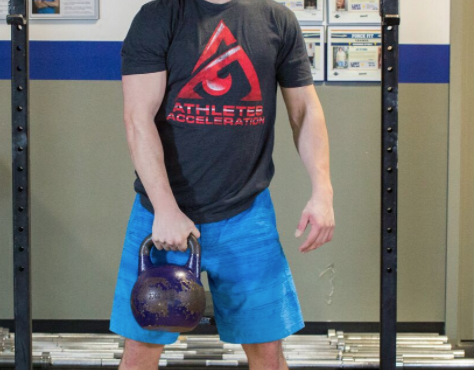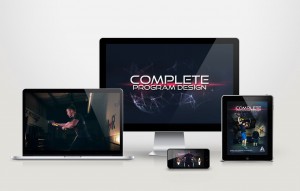5 Steps to a Better Kettlebell Swing
By: Kerry Taylor

All too often I see programs of all levels incorporating the kettlebell into their training, kudos to all of you that have. But please make sure you are using it properly so your athletes can get the optimal benefit of using the kettlebell. It is a great tool with many benefits if used properly. The kettlebell swing is the most commonly used exercise that I see but the technique is usually a little off. When I say off, usually I see people doing a squatting swing, where in all actuality you should be doing a hip-hinging pattern instead. If the swing is done properly, it will help in loading the posterior chain and teach your athlete how to keep a proper flack back and braced core. These are aspects in training that athletes struggle to understand.
So lets get started.
As I mentioned earlier the kettlebell swing is a hip hinge pattern not a squatting pattern. In step one we need to practice getting that pattern down before we load the body. You want to start with feet slightly wider than hip width apart. Too wide and you cannot generate enough power. Squeeze you shoulder blades together and have a proud chest with rubs tucked down. Place your hands on your thighs. Slide your hands down your thighs as far as you can go while driving your hips back towards the wall behind you. Allow your knees to bend. Keep your head in a neutral position, having a gaze slightly in front of you. Repeat 5-10x. If you struggle with this then we will use a dowel to assist with keeping a flat back. When using the dowel, you want to make sure you have 3 points of contact at all times. Those points are your head, upper back and lower back/ glutes.
Hip Hinge:
Hip Hinge with Dowel:
Step 2. Adding outside resistance in the form of a kettlebell or barbell. If you can load this pattern with good form then you can progress to step 3. If you have come to a sticking point here by way of rounding your back or knees shooting forward, then stay here. Lessen the weight, and add the dowel to help trigger the pattern we are looking for. Focus on having a proud chest, squeezing your lats (as if you want to hold a 5 lb plate under each arm pit or bending the bar around your legs) and keeping your head in a neutral position.
BB Deadlift:
KB Deadlift:
Step 3. Now that you have built this pattern into your system and you have conditioned your body with load so the pattern sticks. Now we can start to add a ballistic component to it by way of the dumbbell swing. To perform the dumbbell swing properly, start in that same athletic stance with a flat back (neutral spine). 1 arm extended behind you holding the dumbbell, with it slightly tilted down towards the front of you. Touching the ground and the rear part of the dumbbell elevated. From here you want to aggressively drive your hips forward. While keeping your arms locked out, swing your arm all the way up until your arm gets parallel to your ear. Breathe out as you come to a full stop at the top.
Dumbbell Swing:
Step 4. Now lets start to add in the kettlebell next with a dead swing. Place the bell in front of you with a slight tilt towards your body, with your arms extended out and a flat back. In this position you should already feel your hamstrings engaged and ready to fire. To start the swing, start to drag the bell towards you by pulling down with your lats. As you reach the end of that movement, start to hike the bell behind you and aggressively drive your hips forward and stand up tall, squeeze your glutes tight. Tuck your hips under you and flex your quads. Do not over extend your spine at the top of the swing. Also be aware to not allow the bell to go higher than shoulder height. When the bell descends do not drive your hips back until your arms connect with your hips. Once that happens, then drive your hips back. As you come back to swing forward again, take some juice off of it and set the bell down gently in front of you where you started. That is 1 repetition. When you start with the bell behind you, perform the same as above without the hike.
Dead Swing w/o Hike:
Dead Swing w/ Hike:
Step 5. Once you have mastered the above then we can move on to the regular swing. As we spoke about before, you can start the bell behind you or in front. After you perform the first swing continue to perform this action by absorbing the bell and your arms into your hips. At the top of your swing you should look as if you are holding a high plank or you are in the up push up position. Do not hold your breath, breath out at the top of the movement, have your ribs tucked down.
KB Swing w/ Hike:
KB Swing w/o Hike:
If you are going to have kettlebell swings in your training programs, please add these steps into your programming. Over time your athletes will be swinging the kettlebell properly and getting the full benefit of it.
A few technical adjustments and assistance drills:
-The rope or towel swing
If you notice your athlete using his or her arms to lift the bell then add in this version of the swing. Remember the swing is not an arm or shoulder exercise, it is a full body movement pattern. This version of the swing will correct the pattern and give instant feedback on how to fix it. Run a towel or rope through the handle of the bell. Choke up on the towel or rope. Now perform the swing as normal. If you see the rope bending that will tell you that the athlete is using his or her arms. Once there is a consistent straight line between your arm, and the rope and the kettlebell the energy is coming from the proper area. The key is to stay relaxed.
Rope/ Towel Swing:
If you find the kettlebell is flopping all over the place you may want to try the next size up kettlebell. If you have a strong athlete a light bell will not get the job done. A heavier weight is sometimes self-correcting.
-Barbell Glute Bridge
If your athlete has a tough time firing their posterior chain this drill will certainly help them wake up. The bar should be at the hips. Before engaging in the lift, make sure you have a flat back (neutral spine) while lying down. To start the lift, drive through your heels and lift the bar off the ground. Do not go into excessive extension as that will add unwanted stress to your lower back. At the top, hold for a 1 count and then descend to the ground and repeat.
-Superband Pull Thrus
This will also fire up your posterior chain. The pull thru allows us to strengthen the glutes and hamstrings without overloading the back as you would in a deadlift. You can also use a cable system if that is what you have at your disposal. Vey important to keep the same cues in your mind:
1. Flat back (neautral spine)
2. Drive the hips back
3. Knees stay over the toes
4. Breathe out and drive your hips forward to full lockout position
5. Relax your shoulders and neck
Remember you are moving weight, not lifting weight. Trust your training and focus on your technique. Enjoy
Recommended Athletes' Acceleration
Products
—————————————————————————–




1 Comment for “5 Steps to a Better Kettlebell Swing”